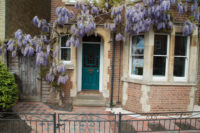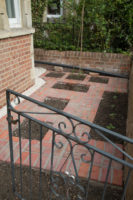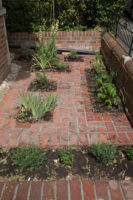A new front garden
Urban front gardens can be a bit of a problem. The traffic noise and fumes, the small size (generally) and the sense that they are really just a space you pass through on your way to and from your front door, or a place to park the car.
But they are also, or can be, a statement of intent. Is this somewhere to store the bins, allow rubbish to accumulate – everything from abandoned needles to abandoned matresses as some front gardens do, or does it reflect something about the care lavished on the rest of home and garden or indeed – this being both private and public space, the attitude towards the neighbourhood? There are plenty of examples of all these approaches on the street that Lord Muck calls home. Indeed it is an extremely diverse and transient street – and a long one. Its thirty odd year since the Muck’s moved in, and the front garden has gone through a fair few of these stages – some of them at the same time. The time when the front of the house fell off due to subsidence early on (in 1989) and had to be taken down and rebuilt was another important factor. As the builders put it at the time, ‘There is enough concrete under that structure now to support a five story block of flats, let alone a bay window’. Planting things in concrete has never been the easiest of things to manage. The front garden wasn’t completely unloved; the hedge survived the builders and looked pretty, and large wooden tubs filled with dahlias and allium brightened things up considerably, as did the glorious wisteria trailing all over the front of the house in the spring, but it suffered from ‘the neighbourhood’; smaller terracotta pots disappeared before the unmoveable half barrels replaced them, the front gate was stolen and passing dogs (or their owners) often found the convenience of those red Victorian tiles well…a convenience.
as did the glorious wisteria trailing all over the front of the house in the spring, but it suffered from ‘the neighbourhood’; smaller terracotta pots disappeared before the unmoveable half barrels replaced them, the front gate was stolen and passing dogs (or their owners) often found the convenience of those red Victorian tiles well…a convenience.
The final straw was the hot summer of 2018. Heat reflected off the street, the front of the house and those aforementioned tiles conspired to make all but the wisteria (deep rooted) extremely stressed by summers end. The hedge began to not just wilt, but die. Time for a re-think. Getting the hedge out was a nasty shock. The heat probably contributed, but the real cause of the problem – honey fungus infection. It can spread through soils very rapidly and wisteria is very vulnerable to it. So a complete re-vamp and redesign looked like it was just in the nick of time, including the installation of deep impermeable membranes to protect the wisteria roots.
So spring has been a time to focus on the new. Oxford Garden Partners came up with a design and planting plan and April and May have seen it gradually take shape. Locally sourced paviers from Matthews of Chesham, repairs to the Victorian tiling, a series of small beds and the space is transformed. Instead of being a sometimes pretty but rather cramped, because of mass of hedge, transit area, it has suddenly opened up into something that feels like a new space, an outside room where perhaps on those quiet sunny Sunday mornings Lord and Lady Muck can partake of coffee and cakes and converse with neighbours and other passers-by
Instead of being a sometimes pretty but rather cramped, because of mass of hedge, transit area, it has suddenly opened up into something that feels like a new space, an outside room where perhaps on those quiet sunny Sunday mornings Lord and Lady Muck can partake of coffee and cakes and converse with neighbours and other passers-by amidst the fragrance of herbs, lavender, irises, hydrangeas and daphne amongst others, that thrive in the warmth. An update at the end of the summer on how this idyll has played out beckons.
amidst the fragrance of herbs, lavender, irises, hydrangeas and daphne amongst others, that thrive in the warmth. An update at the end of the summer on how this idyll has played out beckons.

